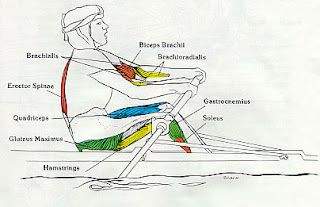Cadangan pembentukan Kelab / Pasukan Mendayung Sekolah Alam Shah, Putrajaya:
1. Pembentukan Kelab/Pasukan
2. Perlantikan Ahli Jawatankuasa
3. Perlantikan Guru/Pegawai/Pengurus Pasukan yang tetap
4. Menetapkan jadual latihan
5. Menentukan kategori dan posisi crew
6. Merangka perlawanan
Pembentukan Kelab/Pasukan:
Memandangkan komitmen yang telah ditunjukkan oleh pihak sekolah, secara peribadi saya mencadangkan pembentukan kelab/pasukan secara rasmi. Dengan penubuhan kelab & perlantikan guru yang bertanggungjawab, segala keputusan & perancangan dapat dibuat dengan teliti. Segala bentuk komunikasi dapat diseragamkan.
Perlantikan Ahli Jawatankuasa dalam kelab:
Berdasarkan pengalaman saya semasa di kampus, perlantikan ahli jawatan kuasa akan dapat melicinkan program latihan di mana jurulatih dapat menumpukan perhatian terhadap pembentukan fasa-fasa latihan. Perlantikan di kalangan pelajar dapat membentuk sifat-sifat kepimpinan dan kemahiran komunikasi sesama mereka. Jurulatih akan memimpin mereka dalam melaksanakan tanggungjawab dan memupuk semngat kerjasama sepasukan.
Selain itu, keperluan ini dapat memenuhi kepentingan mewujudkan pelapis yang akan membolehkan kelab ini terus berdikari dan hidup dengan sokongan pelajar yang lebih berpengalaman walaupun tanpa kehadiran jurulatih.
Perlantikan Guru/Pegawai/Pengurus Pasukan yang tetap:
Perlantikan ini akan dapat membantu jurulatih membuat keputusan dengan persetujuan bersama pihak sekolah. Guru ini akan dapat menyampaikan mesej atau keperluan-keperluan lain yang mungkin timbul. Kehadiran guru ganti tidak menjadi masalah asalkan ada seorang yang boleh membuat keputusan.
Menetapkan jadual latihan:
Jadual latihan telah di faks kepada Presiden PERDAMA. Jurulatih mendapat makluman terus daripada Presiden. Tidak timbul isu besar kecuali jika berlaku perubahan.
Menentukan kategori dan posisi crew:
Kemahiran mendayung memerlukan masa yang agak lama untuk diadaptasi. Untuk membolehkan 4 orang mendayung dengan baik, 5 sessi diperlukan secara berturut-turut bagi melatih mereka. Oleh itu, jika kategori & posisi pendayung dapat dikenalpasti lebih awal, masalah di atas tidak akan timbul.
Pembentukan kelab akan memastikan kesinambungan ini dimana pelajar-pelajar yang mendaftar dengan kelab atau pasukan sahaja yang akan turun untuk latihan.
Merangka perlawanan:
Seperti yang dimaklumkan oleh Cikgu Fadhil, perlawanan antara rumah-rumah akan diadakan. Oleh itu, ketegori bot harus ditetapkan lebih awal. Untuk memastikan kelancaran perlawanan tersebut, semua perkara-perkara atas perlu dipertimbangkan dengan teliti. Saya mencadangkan acara Coxed Four (M4+) & Eight (M8+). Itu bermakna setaip pasukan rumah akan menghantar sekurang-kurangnya 9 orang pemain. Atau 9 pelajar x 6 pasukan rumah, totalnya adalah 54. Tapi jumlahnya agak besar pula. Minima 5 orang sepasukan, atau total 30 pelajar wajib turun setiap kali latihan. Untuk makluman 9 pelajar bermaksud 8 crew + 1 jurumudi (coxwain) atau 5 pelajar bermaksud 4 pendayung bersama seorang coxwain.
Cadangan-cadangan yang tersebut di atas adalah berdasarkan kepada beberapa isu atau rintangan yang dihadapi semasa perlaksanaan program seperti berikut:
- Masalah komunikasi – percanggahan waktu latihan yang tidak tetap, tidak pasti siapa guru yang bertanggungjawab sepenuhnya, tiada keputusan dan sebagainya. Masalah ini diangagap telah selesai dengan penerimaan faksimili yang mengesahkan jadual aktiviti dan guru-guru yang bertugas.
- Penglibatan pelajar tidak konsisten – jurulatih terpaksa mengajar asas rowing setiap kali latihan kerana masih ada pelajar-pelajar yang baru pertama kali terlibat. Kesinambungan latihan kurang berkesan.
- Koordinasi & kerjasama sesama pelajar – Hubungan yang dingin antara sesama pelajar yang dibezakan mengikut tingkatan. Pelajar senior lebih cenderung memerintah daripada menunjukkan tauladan yang baik. Namun kawalan jurulatih mengurangkan dominasi & merapatkan jurang.
Saya membayangkan masa hadapan pasukan junior ini sebagai atlit kebangsaan yang boleh bermula seawal tahun 2010. Itupun bergantung kepada komitmen pihak pentadbiran sekolah dalam memastikan kesinambungan ini. Saya difahamkan terdapat 5 buah sekolah di sekitar putrajaya dimana jika dimanfaatkan “The Junior Boat Race” mungkin boleh diasimilasikan. Wah.. tingginya cita-cita. Tapi mana tahu, ada sejarah yang boleh dicipta.
Nota: Untuk pengetahuan, “The Boat Race” adalah acara klasik & bersejarah selama lebih 150 tahun yang masih dianjurkan hingga ke saat ini. Perlawanan bot eight (M8+) antara 2 universiti terkemuka Britain & dunia di Sungai Thames iaitu University of Oxford dan University Of Cambridge. Sila layari website ini : http://www.theboatrace.org/ untuk lebih maklumat terperinci.
2 Comments



